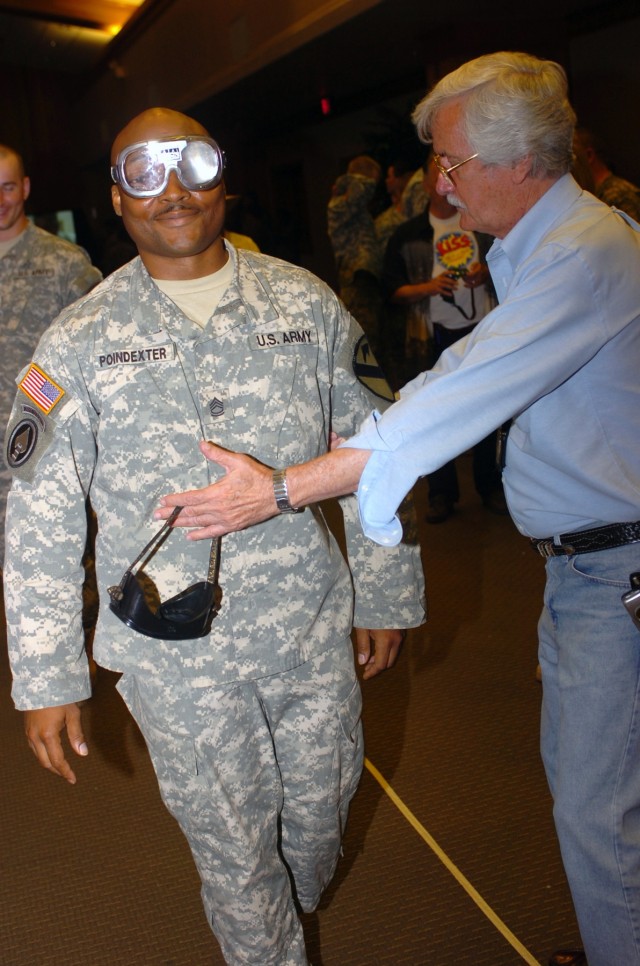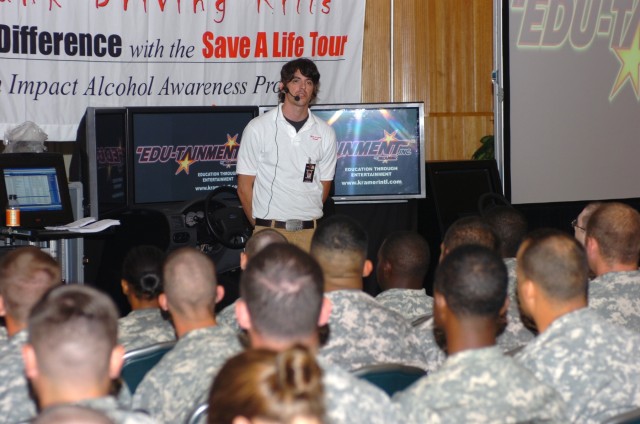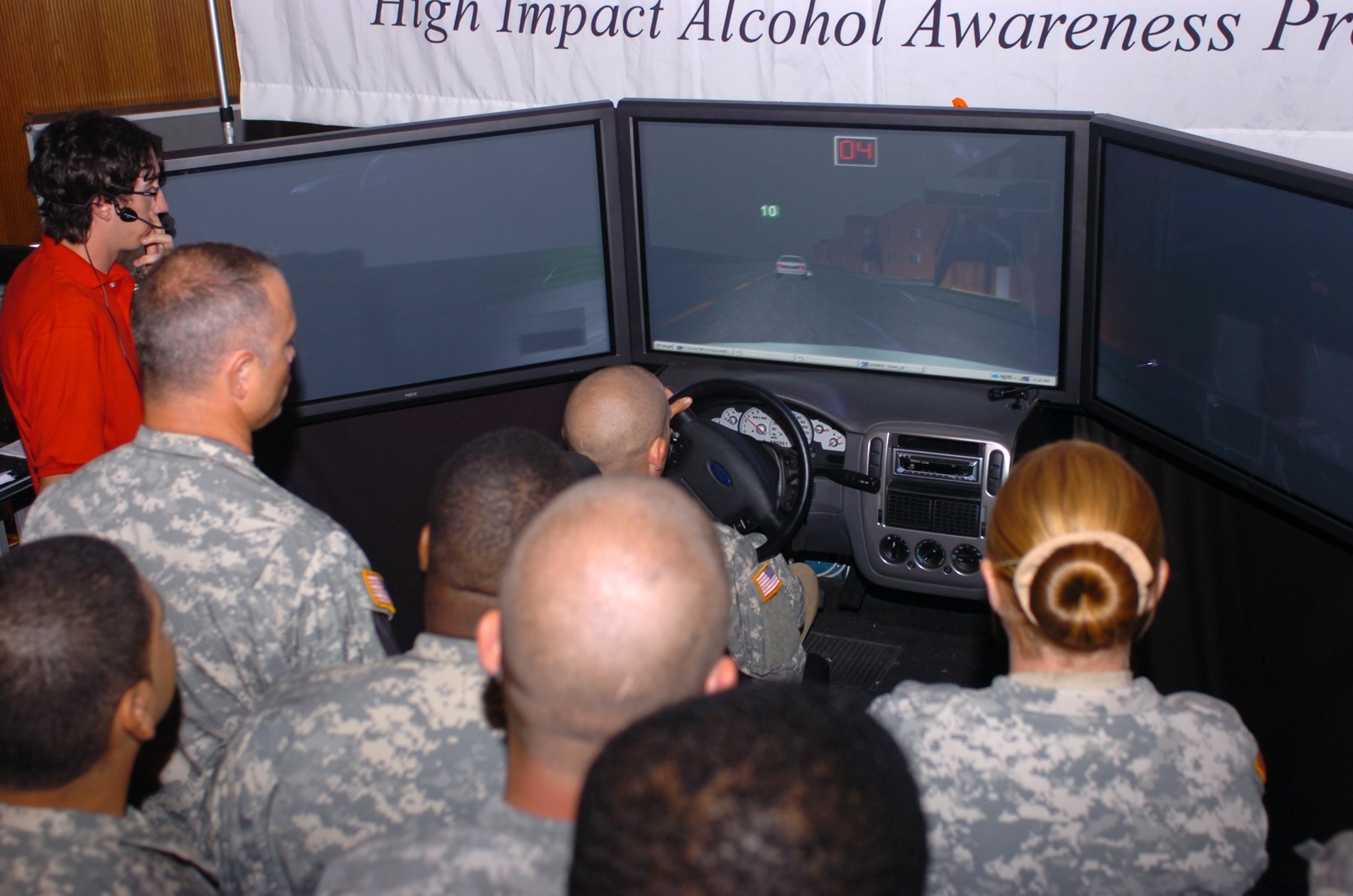FORT HOOD, Texas - Drinking and driving kills, but it can be prevented.
This was the message that members of the 'Save A Life Tour' shared with Soldiers from the 1st Cavalry Division June 27 at the Phantom Warrior Center here.
The 'Save a Life Tour,' which has been referred to as a "high-impact alcohol awareness" program uses a 45-minute video presentation, a multi-million dollar drunk driving simulator, displays, posters and the experiences of the program's facilitators to drive their message home.
The 'Save a Life Tour' was brought to Fort Hood by the installation's Better Opportunities for Single Soldiers program.
During the event, the program's facilitator Brian Beldyga, tour manager for the national 'Save A Life' program, spoke to the audience about his experiences and the loss of his 19-year-old fiancAfA to a drunk driver.
Beldyga started his presentation by explaining that he wasn't there to candy-coat anything.
"Alcohol destroyed my life and has done no good for me whatsoever," said Beldyga during his presentation. "42,000 people died last year in drunk driving accidents, that's just insane."
In the video presentation portion of the program, a young man in the video explained that "this is how it went down" and that the video the Soldiers were about to watch contained no actors, no special effects and "everything you are about to see is real."
Soldiers listened and watched as friends and family members of those who were killed either by drunk drivers or while driving drunk, tearfully spoke of their loss.
Along with that, the video contained graphic footage from actual drunk driving crash sites, strewn with wreckage and the bodies of those who were killed.
After Beldyga had spoken and the video presentation was done, Soldiers had the opportunity to drive the drunk driving simulator which mimics the delayed reactions that occur while driving a car under the influence.
The simulator is a mock up of a car, complete with an air conditioner, radio, steering wheel, brake, accelerator pedal and screens that display what the driver sees.
As the driver goes through a driving scenario in a virtual reality environment, the blood alcohol level rises.
The car simulator basically gets drunk, according to Beldyga, and has slow reaction time, giving the driver in the simulator a good idea of how people react while driving intoxicated.
In addition to the simulator, Soldiers looked at other displays set up to show the effects of alcohol on coordination and other factors.
The troops put on a set of goggles with thick lenses that help to show what happens to a person's coordination when they have too much to drink. After donning the goggles, the Soldiers could barely walk a straight line.
One of the displays included a real casket with an open lid and the words "drinking and driving kills" on the inside lid lining.
Toledo, Ohio native Staff Sgt. Zsabroca Hughes, the installation BOSS president, III Corps garrison, helped bring the program to Fort Hood.
Although the 'Save A Life Tour' has been brought to Air Force and Navy bases, the presentation of the program at Fort Hood this past week marked the first time the 'Save A Life Tour' has been brought to an Army installation, said Hughes.
According to Hughes, the 'Save A Life Tour' is much different than most programs designed to advocate not drinking and driving due to its hard-edged way of presenting information.
"What makes this different is the presenters are hard corps, 'in your face,' and they explain that drinking and driving is a choice and not an accident," said Hughes. "I was first introduced to this program when I attended a conference in February and I've been advocating that we've needed this program."
"When Soldiers drink and drive, they are just one silly decision away from doing something that will affect them the rest of their lives as well as throwing their careers away," Hughes added.
Hughes explained that it was important for her and the installation's command group to show, through the program, that they care about Fort Hood's Soldiers.
"Program's like this are what the BOSS is all about," added Hughes. "Besides being concerned with community service and career progression, BOSS is also concerned with the well-being of Soldiers. It's important that Soldiers know that the command BOSS program and their leaders care about them and that's why we brought the 'Save A Life Tour' here."
Soldiers who experienced the program said it was worthwhile.
"I'm telling our Soldiers to pay attention to the program and to get as much out of it as they can," said Cameron, Mo. native Staff Sgt. Jim Wrex, a trombonist with the 1st Cavalry Division band.
Wrex said that Soldiers can pass on the information that they gained through the program.
"This definitely gives Soldiers a tool they need to circumvent any trouble for themselves, their friends or even a perfect stranger," added Wrex.
Akron, Ohio native Spc. Sean Westfall, a field artilleryman with the 5th Battalion, 82nd Field Artillery Regiment, echoed many of Wrex's sentiments.
"This is definitely a very helpful and meaningful program," said Westfall. "It will save lives."








Social Sharing